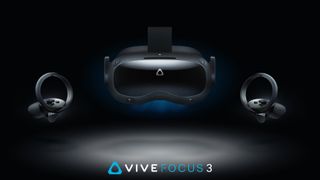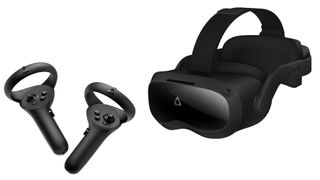HTC Vive Focus 3 proves you can have your (VR) cake and eat it too
HTC Vive Focus 3 sets a new benchmark for all-in-one VR

HTC has unveiled its latest all-in-one virtual reality (VR) headset, the Vive Focus 3, which aims to strike the delicate balance between accessibility and performance.
A massive new 5K resolution is the headline upgrade, representing a 260% pixel increase as compared with the previous generation. The refresh rate has also been boosted to 90hz and the field of view widened to 120 degrees, which should make for a more natural experience with fewer visual quirks.
The Vive Focus 3 is 20% lighter than its predecessor, which will be cause for celebration for anyone that has sampled a battery-powered headset, and HTC has also worked to improve the overall weight distribution to prevent strain on the neck.
- Here's our list of the best video conferencing services around
- Check out our list of the best collaboration tools available
- We've built a list of the best headsets for conference calls right now
The headset comes bundled with new-look infrared controllers, which do away with the trackpad in favor of a traditional joystick and buttons. The new controllers are also rechargeable via USB-C, addressing a common complaint with the previous AAA battery-powered iteration.
While the Vive Focus 3 will naturally draw comparisons with the Oculus Quest, its main rival in the all-in-one market, the two are pitched at different audiences entirely. The Quest is a launch pad for anyone looking to dip a toe in the VR waters, but HTC’s new headset is aimed squarely at business users, and it has a price tag to match.
The Vive Focus 3 will go on sale on June 27 for $1,300/£1,060/€1180 excluding VAT.

The perfect headset for business?
Although the Vive Focus 3 will handle many games quite comfortably, provided they are not too compute-intensive, HTC has been very clear in its ambitions for the new headset.
Are you a pro? Subscribe to our newsletter
Sign up to the TechRadar Pro newsletter to get all the top news, opinion, features and guidance your business needs to succeed!
According to Graham Wheeler, President & GM at HTC EMEA, the Vive Focus 3 will fill a gaping hole in the market for a business VR headset that is accessible and durable, but also offers excellent performance.
“There’s been so much demand for XR solutions for businesses, so we wanted to make a product that was designed from the start for businesses,” Wheeler told TechRadar Pro. “We’re seeing an explosion in people wanting a VR device that is more accessible and the Vive Focus 3 is really setting the benchmark.”
As with previous models, the Focus 3 does not rely on an external PC for power or processing, instead leaning on a specially optimized version of the Qualcomm Snapdragon XR2 platform and a new quick-charge battery attached to the back of the headset.
This means setup should be rapid and users won’t be confined to a designated “playzone”, because tracking occurs from the inside out. Users will be able to pick up their headset and launch into a VR meeting or training session, for example, within a matter of minutes.
For particularly demanding use cases that require extensive simulation - for instance, in the architecture industry - content can also be streamed to the headset via PC, with fully wireless streaming support promised for some time in the future.
In terms of design, HTC was careful to equip the Vive Focus 3 with facilities that allow for intensive use by multiple people, such as swappable batteries and face gaskets. There’s also no foam in sight, which the company says makes disinfecting the headset far easier - an absolute must in the context of the pandemic.
“One of the things you have to consider is that business headsets are used a lot more, by multiple people each day. And, unfortunately, the headsets are not handled as carefully by users,” explained Wheeler.
“To combat this problem, we built the chassis out of magnesium alloy, which is 20% lighter than plastic but 500% stronger, so the headset will withstand all the knocks and bumps of everyday usage. And it will always look as good as it did on day one.”
TechRadar Pro will bring you a full review in the summer, once the Vive Focus 3 hits the shelves.
- Here's our list of the best productivity software available

Joel Khalili is the News and Features Editor at TechRadar Pro, covering cybersecurity, data privacy, cloud, AI, blockchain, internet infrastructure, 5G, data storage and computing. He's responsible for curating our news content, as well as commissioning and producing features on the technologies that are transforming the way the world does business.
Most Popular
